China Must End Reprisals against Protestors, Investigate Urumqi Fire, Free Detainees
December 2, 2022 Comments Off on China Must End Reprisals against Protestors, Investigate Urumqi Fire, Free Detainees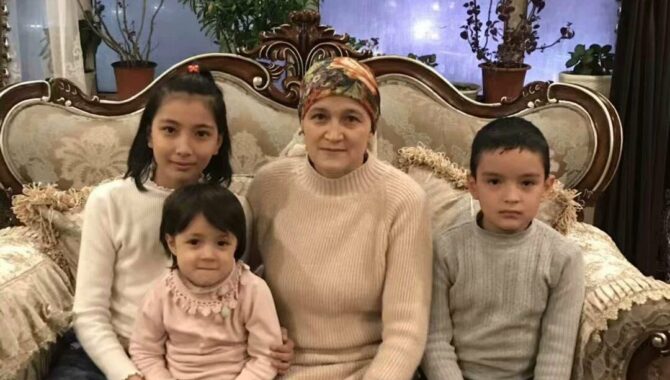
(Chinese Human Rights Defenders, December 2, 2022) Chinese police are engaging in systematic reprisals against protestors who took to the streets across China to call for an end to inhumane “zero-COVID” lockdowns, mourn victims of the November 24 apartment fire in Urumqi, and demand political change.
“The outpouring of grief and empathy have united Han Chinese and Uyghurs. People have woken up to the reality that no one under Xi Jinping’s rule can escape the extraordinarily harsh and inhumane measures, which have had fatal consequences, and for which victims of the Urumqi fire paid the price with their lives,” said Renee Xia, CHRD Executive Director.
“We just witnessed one of the most significant protest movements in China since 1989, but now many of these brave protestors are at grave risk of being disappeared and tortured. The Chinese government is likely to put many of them in secret detention facilities and deny their due process rights,” said William Nee, CHRD’s Research and Advocacy Coordinator.
We at CHRD are seriously concerned that detained protestors are at high risk of being forcibly disappeared and subjected to torture and deprivation of due process rights. This is in light of the Chinese government’s track record of rights abuses of detained or jailed critics who have previously expressed dissent over Xi Jinping’s COVID polices and his increasingly dictatorial governance.
“The international community – heads of governments, international organizations, and private sectors and civil society leaders —must speak out now, loud and clear, to condemn the unfolding crackdown on demonstrators exercising their freedom of expression and peaceful assembly guaranteed under international human rights law and the Chinese Constitution,” said Ramona Li, CHRD Senior Researcher and Advocate.
People across China showed up in historic numbers in the streets and on college campuses to mourn victims of the Urumqi fire on November 24 and vent outrage over strict COVID lockdown measures. They demanded lifesaving measures that would require easing the daily suffering that the government has inflicted on them in the name of pandemic control. The protests in some cities quickly turned into demonstrations against the escalating repression under Xi Jinping’s one-man dictatorial rule. Protestors demanded Xi and the Chinese Communist Party step down and voiced their desires for democracy, human rights, and rule of law. Police harassed and intimidated demonstrators, dragging scores into vehicles.
Authorities are also cranking up censorship online and deploying large numbers of security guards to cordon off roadways, conducting door-to-door inspections, searching cellphones for protest-related content in the streets, and arresting people who continue to protest.
What we know so far:
Deaths in the Urumqi Fire: victims of not only zero-COVID lockdown
The fire, reportedly ignited by a faulty electrical strip, engulfed the upper floors of a building in the Jixiangyuan apartment complex located in a major Uyghur neighborhood in Urumqi, the capital of Xinjiang Uyghur Autonomous Region. Official news outlets have reported that 10 people died and 9 were injured, but local police contacted by RFA gave much higher estimates. An Ittipaq Road Police Station officer gave an estimate of around 26 (9 from burns and the rest from suffocation), and a Janubiy Road Police Station officer reported that the likely death toll is over 40.
Public information about the fire has been limited as authorities have come to regard the incident as a national security issue. Officials have reportedly taken the survivors into custody at the Ruida Hotel in Urumqi and confiscated their phones. They have also detained neighbors and friends of victims who have posted information about the incident online.
CHRD has identified ten victims from three families. One is a mother and her four children: Qermenisa Abduraman (48), and her children Shehide (13), Abdurahman (9), and Nehdiye (5). A fourth child, Imran (11), who also died, is pictured below with his sister Shehide. They lived on the 19th floor.
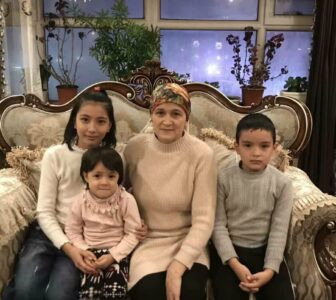
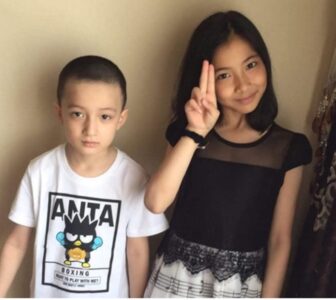
Siblings Elzat Eziz (14) and his sister, a medical student (21, name unknown) reportedly perished in a stopped elevator that would not open because their floor was locked down as a COVID-control measure.
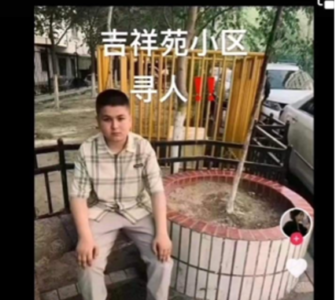

The deaths include a third family – a mother, Gulbahar, and her two children (not pictured). The younger child was three years old. A social media posting indicated that the family had been quarantined for 105 days before the fire.

Chinese citizens across the country identified themselves with the victims as they themselves may as well have been among the deaths and they have also witnessed many other preventable deaths due to the extreme COVID lockdown measures.
“Yet, the Chinese government’s discriminatory ethnic policies and counter-extremism measures targeting Uyghurs and other predominantly Muslim groups have been significant contributing factors in the deaths, torture, enforced disappearances in the region in the recent years. Such measures may have also contributed to the loss of lives in the fire,” said Ramona Li.
According to Uyghur linguist and writer Abduweli Ayup, concrete barriers preventing fire engines from reaching the building “were installed at the apartment complex in 2017 as part of the Xinjiang government’s counter-terrorism campaign.” They were not barriers put in place to control exits during the COVID lockdown, as many have assumed.
The wide-scale counter-terrorism campaign targeting Uyghur culture and society had already torn apart many of the families living in the apartment complex. Many of the men had been imprisoned or interned. Most of those who remained in the apartments were women and children, as indeed is the case of all of the victims publicly identified thus far.
Qemernisa’s husband was sentenced to 16 years in prison sometime around 2017, and shortly afterward her oldest son was taken to a re-education camp. In the last five years of her life, she had not spoken to her two older children living in Turkey because of the severe consequences for Uyghurs who make contact with relatives abroad, particularly in Muslim-majority countries.
COVID lockdowns have been harsher in Xinjiang, particularly when enforced against Uyghur and other majority-Muslim groups. Uyghurs have also been threatened with internment for violating lockdowns, and there have been frequent reportsof bars and chains placed across apartments’ doors and fire exits, making it impossible for families to leave their homes for any reason. There are also reports of Uyghurs under lockdown facing life-threatening food shortages that have gone unaddressed by authorities.
Those observed protesters in Urumqi are most likely to be Han Chinese, judging from their accents and appearance. Uyghurs and other non-Han groups in Xinjiang face much higher risks for publicly expressing dissent, with their ethnic identities already making them the object of extraordinary restrictions in daily life. They are more vulnerable to imprisonment and internment in re-education camps.
Mass protests spread like wildfire
When spontaneous protests erupted in Urumqi on November 25, demonstrators expressed demands for ending the lockdowns and aired frustration over disregard for lives and food shortages. As mourners and protestors poured into Shanghai’s Urumqi Road on the following day, speeches and chants connected the fatal consequences of “zero-COVID” lockdown to the Chinese political system. Protestors chanted “Communist Party: Step Down!” “Xi Jinping: Step Down!” Other cities followed suit.
On November 27, a crowd in Beijing gathered under the Sitong Bridge and chanted the demands on the banners hung from the bridge by a lone protester, Peng Lifa, who was detained and forced into disappearance, less than a month prior: “We want food, not COVID tests / Freedom, not lockdowns / Dignity, not lies / Reform, not Cultural Revolution / Elections ballots, not a ruler / To be citizens, not slaves.”
These demands were echoed in protests against not just local authorities for specific issues but Xi’s dictatorship in many other cities, with protestors also chanting, “Give me liberty, or death!” in what has come to be known as the baizhi geming (The White Paper Revolution).
Initium Media found that there have been 106 protests on university campuses throughout China, as of November 27:
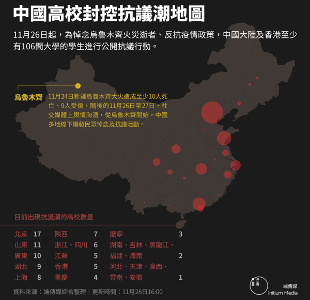
[Map from Initium Media]
Underscoring the unprecedented scope of the protests, likely since 1989, the Australia Strategic Policy Institute (ASPI) catalogued 58 protests in 28 cities from November 26-December 1.
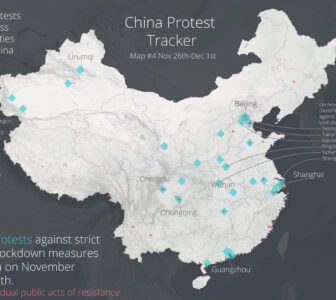
[Map and dataset provided by Nathan Ruser and colleagues, Australian Strategic Policy Institute]
Top leadership swiftly orders hard crackdown
On November 29, the Central Political and Legal Affairs Commission, the Chinese Communist Party organ that oversees law enforcement, prosecution, and the judiciary, convened an emergency meeting, chaired by Chen Wenqing, a member of the Politburo Standing Committee and Secretary of the Commission. The meeting was followed by official announcement that relevant organs must “resolutely and according to the law strike hard against the infiltrating and destructive activities of the hostile forces and against illegal criminal behavior that disrupts social order, and earnestly maintain the social order regarding the overall picture [the CCP’s leadership].”
Since then, a wave of detentions has ensued.
Police began detaining demonstrators, forcing some into disappearance
At the time of this statement’s release, there have been many online-circulated video/audio clippings, photos and text messages of police dragging people away, forcing them into vehicles, or making arrests at homes. Participants, bystanders, and journalists shared some information about police rounding up protesters.

Figure 1 Shanghai, Urumqi Middle Road, November 27
Online censors have further tightened information blockade. Police have mobilized the grid-management apparatus in city neighborhoods and visited residents door-to-door to conduct search and issue stern warnings, including threats against talking to foreign journalists.
Scarce information filtering out suggests that arrests are underway in Yunnan, Hangzhou, Guangzhou, Beijing, Shanghai, Changesha, Xiamen, and elsewhere.
Activists and netizens across China are scrambling to account for those known to have protested and since been detained by police. In many cases, the names of detainees, other details about them, or the total numbers are largely uncleared or unconfirmed. However, information about some cases of detention and subsequent disappearance are starting to trickle in.
CHRD has gathered the following cases with few details of detainees’ identities and the circumstances or nature of their detention.
- One protester, who goes by the name Chuanchuan (川川) online, was forced into a police vehicle, with a dozen other protesters, guarded by 3-5 police officers in Shanghai, near Huaihaizhong Road on November 27. She managed to send out a few messages in WeChat groups from her phone before she could no longer be contacted.
- A protester named Jin Jiawei (金嘉伟) was seen detained by police at Urumqi Road in Shanghai in the evening on November 27; they have not been heard from since their detention.
- A man, dressed in black, wearing dark-color gloves, short curly hair, who appeared to witnesses to be an ethnic Uyghur (name unknown), was seen being taken away by police at Wangping Road, Chengdu, the site of a protest on November 27, at around 10:00 pm, who has since gone missing.
- Also in Chengdu, near Wangping Road, on November 27, at approximately 9:00pm, about 50 people at the scene of a protest were said to have been detained and taken to the Longquanyi police station. Friends of some of the detained said they still could not reach them more than 30 hours later.
- A person with the WeChat account name of Linrimbaud (林怼怼) [RX1] has gone missing in Shanghai since the late night of November 28 or early morning of November 29. Police knocked on the door, demanded to search mobile devices, while Lin was on the phone talking to a journalist.
- On Twitter, activist Wang Qingpeng shared that Jing Xueqin (景雪琴), using the name Li Xiaoxiao (李笑笑) was taken away by police in Wuhan, at around 11:30pm on November 28 for participating in protests. Ms. Jing was able to send a last text message to friends that she was detained at the Changfeng Station in Jiaokou District in Wuhan.
- A protester named Li Kangmeng (李康梦) has gone missing near Nanjingxi Road, Shanghai, on November 30, and is feared to have been detained.

Figure 2 Li Kangmeng
- On November 28, around 4:00pm, a man named Li Mu (李牧) was reportedly detained in the Jinshui District, Zhengzhoul, Henan province, for posting protest messages in the streets, according to a netizen group that collects and releases information on a Telegram Channel.
- A person named Huang Tai (黃昊) who was apparently at the protests on Urumqi Road in Shanghai was taken away on November 26, whose whereabouts remain unknown, according to information posted on the Telegram Channel.
- The Telegram Channel posted a notice looking for a missing friend in the online name @_山崎愛_ , saying that this friend, a student at Shandong Yantai University, was found to have joined a protest. The student has since disappeared.
- The Channel also posted that demonstrators Xiu Di (修迪) and Wang Daiyue (王黛玥) were detained and put on a bus in Shanghai on November 27. They were said to have been taken to Xujiahui Police Station and they have been missing since.
- The Channel posted the messages that Wang Chenghao (王晨皓), likely a student protester, and his girlfriend went missing on November 28, in Shanghai.
- On November 27, around 10pm, at the demonstration on Urumqi Road, Shanghai, Qin Cao (秦超), resident of Anhui province, was taken away by police. His whereabouts remain unknown.
- Shanghai resident Chen Jialin (陈佳林), was taken away near the subway station, on her way home from protests at Urumqi Road. She was talking to a journalist on her cellphone when a policeman from the city’s Railway and Transportation PSB detained her. As of November 29, at around 10pm, she was detained at Shanghai No. 2 Detention Center.
- A protester was filmed as police wrestled him away while he cried, “Let me speak just once! Why not allowed?…” in Shenzhen on November 29. Details about this detainee are unavailable.
- One video showed police in Urumqi entering the home of a woman to summon her to the police station for a WeChat post she had sent out. Details about this detainee are unavailable.
Some detainees may have been released. This is a very fluid situation, which we are closely monitoring, and continue to verify the incomplete or unconfirmed information.
“Xi Jinping is likely still deciding how to handle all of those who remain detained, so it is vital that the international community speak out now to remind the Chinese government of its obligations under human rights law. Putting pressure on the Chinese government now can potentially help avoid a worst-case scenario for the protestors,” said William Nee.
CHRD is alarmed at the unfolding familiar pattern that Chinese authorities have shown in mishandling the protesters, a pattern that has been time and again used in recent years. Authorities have notoriously placed detainees who participated in larger scale human rights campaigns under enforced disappearance and torture, including Charter 08signatories in 2008-09, human rights lawyers in 2015, labor organizers in 2019.
We have reason to fear that the detained protesters are at high risk of being subjected to enforced disappearance and torture, especially in view of the government’s recent track record of detaining and penalizing whistleblowers, citizen reporters, and critics of government responses to COVID outbreak and Xi’s “zero-COVID” policy, and subjecting them to enforced disappearance, torture, and depriving them of due process rights including denying them access to lawyers of their choice, for example:
Ji Xiaolong, an online citizen reporter based in Shanghai, was taken away by police on August 31, 2022, and arrested on September 23 on the charge of “picking quarrels and provoking trouble,” likely in retaliation for an open letter he wrote criticizing then-Party Secretary of Shanghai Li Qiang and the supreme leader Xi Jinping. He is currently being detained in a room overly crowded with 60+ people, which was only meant for 25 people, and he is suffering from severe tooth aches and has being blocked from seeing a dentist.
Peng Lifa, an aerospace researcher, staged a one-man protest in Beijing on October 13, 2022. Peng spread a banner over the Sitong Bridge. Peng was promptly detained after and his whereabouts remain unknown.
Zhang Zhan, a citizen journalist, was detained and put on a trial and convicted in a Shanghai court on December 28, 2020 on a charge of “picking quarrels and provoking trouble.” The court sentenced her to four years in prison. The court cited as “evidence” of her criminality the reports on the COVID outbreak in Wuhan, which she uploaded to Youtube and Twitter. The court denied Zhang the right to a fair trial. She told her lawyer that she went on hunger strikes to protest being subjected to torture.
Fang Bin, a citizen journalist and rights activist, went missing after being taken away by police on February 9, 2020. His family has not received any legal notification concerning his detention. In February 2022, we learned that he was being held at a detention center in Wuhan, but he still did not have access to a lawyer.
Chen Mei and Cai Wei, citizen journalists who were detained and eventually sentenced to 15 months in jail on the charge of “picking quarrels and provoking trouble.” They were never allowed to meet lawyers of their choice.
He Fangmei, a health rights defender, who drew public attention to faulty vaccines made by state manufacturers, was forcibly disappeared for nearly two years. She went missing after staging a protest in front of China’s National Health Commission in Beijing as China started to launch its COVID-19 vaccination drive in October 2020. He Fangmei went on trial sometime during the spring of 2022, but the details remain unclear.
Lawyers offering legal service under intimidation
Dozens of Chinese lawyers showed their support by offering their legal services for detained protestors.
These lawyers have quickly come under tremendous pressure from authorities, who issued stern warnings of severe consequences if they take on these cases.
Human rights lawyer Wang Shengsheng told Radio Free Asia, “Our phones were bombarded because many people had lost contact with their friends, and we found that people had been taken away in many different places, including Shanghai, Beijing, Ningbo, Kunming, Yunnan and Guizhou.” Wang also said, however, lawyers who offered their service haven then received threatening, often anonymous, phone calls.
Wang Qingpeng said on Twitter that human rights lawyer Lu Siwei had received a threatening phone call in which the person asked if he supported the student movement. Lu asked the caller to identify himself, and the caller replied: “I’m your Father.”
Lawyer Lu Tingge also said that he received threating phone calls.
Harassing and persecuting human rights lawyers is in the Chinese authorities’ notorious “playbook” – lawyer Li Yuhanremains in jail for taking on the legal defense of the July 2015 crackdown detainee, lawyer Wang Yu, who had been detained for defending other detained human rights defenders. Several human rights lawyers had their law licenses revoked by authorities after defending Hong Kong protestors.
Intimidating journalists, suppressing press freedom
The Foreign Correspondents Club of China said in a press release on November 28 that many foreign journalists across the country were physically harassed while covering the protests. In the most egregious example, on November 26 in Shanghai, Edward Lawrence, a BBC journalist licensed by the Chinese government, was beaten, dragged across the ground, and detained for hours while filming protests.
In addition to widespread censorship on social media, Chinese authorities are also using more low-tech means to prevent citizens from recording the protests. In Shanghai, police were seen checking phones of people on the subway, looking for any photos or videos related to the protests.
What Needs to Happen
The Chinese government must:
- Make public information about the victims, including the outcome of any investigation of the Urumqi fire, and hold any officials responsible for blocking the building exits and fire routes of the apartment complex criminally accountable.
- Release protestors and drop all charges that may have been issued against them for their exercise of the rights to freedom of expression and peaceful assembly. Under international law, restrictions on peaceful assemblies are only permissible if they are necessary to protect legitimate public interests or the rights of others. Any legitimate restrictions must be proportionate and the least restrictive available.
- Ensure that all individuals taken into custody are officially accounted for and are held in officially recognized places of detention.
- Ensure that all persons detained are given access to a lawyer of their choice promptly after their detention.
- Refrain from using “residential surveillance in designated location” (RSDL) to lock up protestors. Detainees in RSDL are kept in secret locations for up to six months without any access to lawyers or judges or family members, where they are at high risk of torture. UN human rights experts have called RSDL tantamount to enforced disappearance and have repeatedly urged China to abolish it.
- Stop harassment and intimidation by police and officials of Chinese citizens, aimed at preventing them from peaceful assembly and freely expressing their views.
And various stakeholders in the international community must:
- Speak out and urge the Chinese government to abide by its international obligations to respect human rights, including the rights to freedom of peaceful assembly and expression, the rights to participate in a democratic policy making process, including COVID prevention policies;
- Demand that the Chinese government release anyone who has been detained while exercising their human rights;
- Take immediate actions to implement the recommendations in the UN High Commissioners’ August 2022 report on the human rights situation in the Xinjiang Uyghur Autonomous Region.
